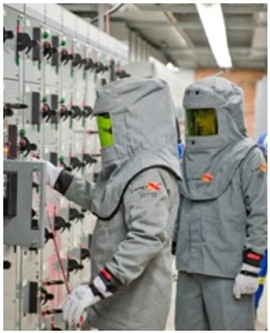The Shocking Need for Electrical and Arc Flash Safety
Electricity has been generated in power stations since 1882. Due to increased efficiency, world energy consumption was cut down by 1.5% in 2009, for the first time since World War II. The continuous increase in efficiency will result in less electricity needed for a given demand of electrical power. But since the demand will continue to grow (mostly because of the electrification of heating and transportation and the growing economies in developing countries), the world energy consumption is projected to increase from 549 quadrillion Btu in 2010 to 815 quadrillion Btu in 2040, according to International Energy Outlook 2016 (IEO2016), released by the U.S. Energy Information Administration (EIA).
Over the last decade, occupational safety experts have become aware of the increased frequency and the severity of electrical arc flash hazards. Utility, solar, wind and power generation industries, hospitals, universities and colleges, food processing and packaging plants, breweries, bakeries, dairies, paper and pulp manufacturers are just a few of the environments where arc flash events may occur. The danger of exposure to arc flash hazards is on the rise due to an increase in overall energy use, higher system voltages, and available fault currents.
What is Arc Flash?
An arc flash is the light and the heat produced from an electric arc supplied with sufficient electrical energy to cause substantial damage, harm, fire, or injury. Arc flash hazards/blasts typically last less than 1 second. The blast is of an extremely high thermal energy level, up to 35,000 degrees Fahrenheit, measured in Cal/Cm2. It also causes a pressure wave from expanding metallic material into the vapor.
Electric blasts can most commonly happen during these activities:
- Voltage testing by an electrician or maintenance worker;
- Removing bolted panel covers;
- Inserting or removing circuit breakers;
- Catastrophic failure of electrical equipment during normal operation from wire anomalies or internal failure;
- Troubleshooting live electrical circuits;
- Racking and unracking circuit breakers during normal operation.
OSHA Standards
Published by OSHA on April 11, 2014, revisions to OSHA 1910.269 address the frequency and magnitude of arc flash hazards in high-voltage utilities and industrial facilities that operate power generation, transmission and distribution equipment.
What are NFPA 70E and CSA Z462?
The US National Fire Protection Association’s NFPA 70E Standard and the Canadian CSA Z462 Standard define the requirements for occupational electrical safety. Both standards define best practices for performing work near energized electrical equipment that includes work plans, hazard analysis, engineering control, workforce training, and proper use of PPE. Any person working with energized electrical equipment operating at 50 volts or more must comply with these safety standards.
Resources for Reference: nfpacatalog.org
NFPA, NFPA 70E Online Standard for Electrical Safety
The NEC® (also referred to as NFPA®-70) is issued by the National Fire Protection Association (NFPA®) and addresses proper installation and use of electrical systems and equipment in buildings and structures so as to help protect people and property from potential hazards.
The main types of systems and equipment addressed include:
- Installations of electric conductors and equipment within or on public and private buildings or other structures (mobile homes, recreational vehicles, floating buildings), and other premises (yards, carnivals, parking lots, and industrial substations);
- Installations of conductors and equipment that connect to the supply of electricity;
- Installations of other outside conductors and equipment on the premises;
- Installations of optical fiber cable;
- Installations in buildings used by the electric utility (office buildings, warehouses, garages, machine shops, and recreational buildings that are not an integral part of a generating plant, substation, or control center).
How to Conduct a Hazard Analysis/Assessment
NFPA 70E-2012 includes Table 130.7(C)(15)(a) for AC (Alternating Current) tasks and 130.7(C)(b) for DC (Direct Current) tasks. These tables provide common work tasks and the corresponding required clothing.
The requirement for assessing the workplace to determine if hazards are present (including the electrical hazards of shock/arc flash) has been in effect for 40 years.
NFPA 70E-2009 made several revisions to the requirements. One significant revision was the inclusion of the requirement to consider the design of the overcurrent protective device and its opening time, as well as the condition of maintenance as part of the arc flash hazard analysis.
“ 1926.960(g) Protection from flames and electric arcs. (1) Hazard assessment. The employer shall assess the workplace to identify employees exposed to hazards from flames or from electric arcs. (2) Estimate of available heat energy. For each employee exposed to hazards from electric arcs, the employer shall make a reasonable estimate of the incident heat energy to which the employee would be exposed.”
Why Do We Recommend Using Oberon Brand Electrical Safety Gear?
Oberon has been in the safety business for almost 75 years. They are a manufacturer of high-quality safety spectacles, face shields, cover goggles, and welding helmets, focusing on Arc Flash protection for the last 30 years. To maintain consistent quality and delivery, Oberon manufactures its specialty products in the USA.
Three Types of Arc Flash Suits from Oberon
Overview of the three different series of Arc Flash suits and face shields that come with them:
- CAT Series FR Treated Cotton is the most economical choice, perfect for infrequent use; however, it is less durable than Arc Series and is not as comfortable as LCI suits;
- LCI Series Inherently FR is more economical than the Arc Series and is the best option for semi-frequent users of the Arc Flash PPE;
- Arc Series with a True Color Grey face shield is extremely comfortable and durable, suitable for frequent users who need the suit every day.
What does HRC Mean?
Hazard/Risk Category (HRC) is the term used within the current NFPA 70E and CSA Z462 Electrical Safety Standards. It describes the potential thermal energy of an arc incident to which the worker could be exposed and the arc-rated PPE requirements. Arc Rating from 0 to 7 is expressed in calories with 7 being the highest electrical hazard risk requiring the highest protection level. Since the electrical hazards do not stop at 40 calories, Oberon created additional categories: ORCs. This table provides an overview of HRC and ORC categories classification.
Electrical Arc Safety Hazards
| Types of Hazards/Risk Category | Task Hazard Range | PPE Protection Minimum |
|---|---|---|
| HRC 0 | No hazard | Garments constructed of non-melting, untreated natural fiber |
| HRC 1 | Task up to 4 calories | 4 calories |
| HRC 2 | Task up to 8 calories | 8 calories |
| ORC 2 | 10 calories | |
| HRC 3 | Task up to 25 calories | 25 calories |
| HRC 4 | Task up to 40 calories | 40 calories |
| ORC 5 | 65 calories | |
| ORC 6 | 100 calories | |
| ORC 7 | 140 calories |
Selecting the Right Protection
PK Safety and Oberon Company are trained and can assist with guiding you through the selection process once you know the risk/hazard level of your workspace.If you have questions or would like help selecting the right equipment for your application, please give PK Safety folks a call at 1-800-829-9580, or go to pksafety.com.
Recent Posts
-
Promoting Safety: National Work Zone Awareness Week is April 15-19, 2024
Each year, the National Work Zone Awareness Week (NWZAW) places the spotlight on the importance o …Apr 11th 2024 -
Understanding 4 Gas Monitors: How They Work & Why They Are Important
In today’s increasingly dynamic industrial landscape, 4 gas monitors have emerged as critical com …Apr 8th 2024 -
April Showers Require Workers to Wear Hi-Vis Safety Rain Gear
While April showers bring May flowers, they also bring challenges, particularly for those working …Apr 1st 2024






